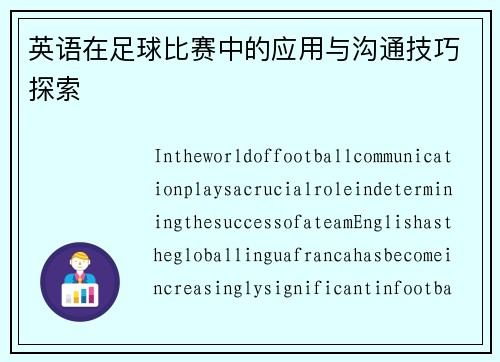英语在足球比赛中的应用与沟通技巧探索
In the world of football, communication plays a crucial role in determining the success of a team. English, as the global lingua franca, has become increasingly significant in football communication. This article explores the use of English in football matches and examines various communication techniques used on the pitch. Through the analysis of four major aspects—verbal communication, non-verbal communication, tactical instructions, and team cohesion—this article highlights the importance of mastering English for effective communication in football. A closer look at these facets reveals how players and coaches use the language to enhance performance and build stronger team dynamics.
1、Verbal Communication on the Field
Verbal communication is one of the most direct forms of interaction between players during a football match. English serves as a common language in international competitions, ensuring that players from diverse linguistic backgrounds can understand each other. Coaches often use English to provide instructions, make quick decisions, and offer encouragement or feedback. For instance, a coach might shout commands like "Pass the ball!" or "Defend now!" during critical moments of the game.
Effective verbal communication requires clarity and precision. In fast-paced football matches, players need to convey information succinctly to ensure everyone is on the same page. This involves using simple and direct phrases that players can respond to quickly. For example, a defender might call out “Man on!” to alert their teammate of an opponent’s close presence. These short, action-oriented phrases are key in maintaining a fluid and responsive team dynamic.
9球直播Moreover, the use of English allows players to communicate with referees, who are often from different countries. The consistency of referees’ decisions and the enforcement of rules depend on the shared language of communication. Players need to be able to communicate effectively with referees, especially in tense moments, such as arguing a decision or seeking clarification on a foul.
2、Non-Verbal Communication in Football
Non-verbal communication is an equally important aspect of interaction in football. This form of communication transcends language barriers, as players use body language, gestures, and eye contact to convey their intentions. Non-verbal cues are particularly useful when verbal communication might not be possible due to noise or time constraints. For example, a captain might use hand signals to organize players during a free kick, or players might make eye contact to signal an understanding or an intention to pass the ball.
Additionally, non-verbal communication can help convey emotions or reassure teammates. A pat on the back or a thumbs-up can boost morale during a challenging match. Coaches also use non-verbal cues to communicate with players from the sidelines, such as gesturing for a substitution or making tactical adjustments without speaking a word. This silent communication can often be as powerful as verbal instructions, as it is immediate and visual.
In terms of team coordination, non-verbal communication helps players anticipate each other’s movements. For instance, during set-piece situations, players often use subtle body movements or facial expressions to signal their intentions or to deceive their opponents. These unspoken signals form an integral part of the team's strategy and help create synergy on the pitch.
3、Tactical Instructions and Team Strategy
Tactical instructions are a fundamental part of football communication, and English plays a central role in the delivery and understanding of these instructions. Coaches use English to communicate their game plan, make adjustments, and provide tactical guidance. Whether it is before the match, during halftime, or in the midst of the game, clear tactical instructions can make a significant difference in how a team performs.
During matches, coaches often shout specific tactical instructions, such as "Press high!" or "Hold the line!" These short, directive phrases help players understand their roles in real time. English has become the dominant language in professional football, and this linguistic standardization allows for more efficient and streamlined communication of complex tactical strategies. Players must be able to quickly process and act on these instructions to maintain tactical discipline.
Moreover, the use of English in tactical discussions is essential when coordinating with international players. When teams consist of players from different countries, a common language like English ensures that all players understand the coach’s vision, regardless of their native tongue. English enables the coach to translate complex strategies into clear, actionable points that all players can follow, creating unity and clarity within the team.
4、Building Team Cohesion through Communication
Team cohesion is vital for success in football, and effective communication is key to fostering a strong, united team. The ability to communicate clearly, whether verbally or non-verbally, helps create trust and understanding between teammates. This unity can lead to better teamwork, coordination, and a more harmonious atmosphere both on and off the pitch.
English serves as a bonding tool among players who speak different languages. The use of a common language allows players to connect with each other on a deeper level, share experiences, and collaborate more effectively. Whether in the locker room or during team-building exercises, English facilitates social interaction and helps build friendships that can enhance performance on the field.
Furthermore, coaches often use English to motivate players, ensuring that the entire team stays focused and positive. Clear communication about the team’s goals, aspirations, and values helps players stay aligned with the team’s mission. When players understand their roles and feel part of a cohesive unit, they are more likely to perform at their best. In this way, English not only serves as a tool for tactical instruction but also as a medium for fostering camaraderie and a winning team spirit.
总结:
In conclusion, English plays a pivotal role in the communication dynamics of football. From verbal commands to non-verbal cues, the use of English helps ensure that players, coaches, and officials can work together efficiently, regardless of their linguistic backgrounds. Effective communication—both verbal and non-verbal—improves team coordination, sharpens tactical execution, and fosters a unified team environment.

The exploration of how English enhances communication in football illustrates its importance not only in international competitions but also in the daily functioning of teams. As football continues to evolve, the mastery of English as a tool for communication will only become more integral to success on the global stage. For players and coaches alike, improving English language skills is no longer just an asset but a necessity in the increasingly international world of football.

